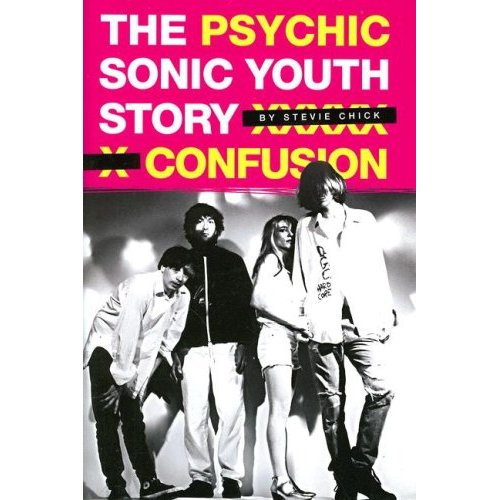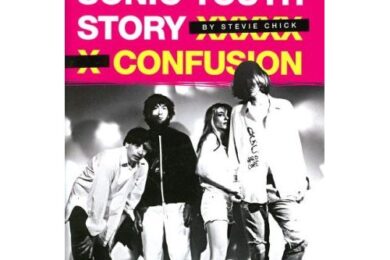Our good friend and gentleman of rock writing, Mr Stevie Chick recently had his book on Sonic Youth published by Omnibus. Here for your delectation is an extract concerning the release of their early, genius album Bad Moon Rising.
All pictures by Maria Jefferis Shot2Bits.
Shortly after Bad Moon Rising was completed, Thurston Moore sent a cassette with six tracks from the sessions to Paul Smith in England, on his friend Lydia Lunch’s suggestion. "When I listened to the cassette, Sonic Youth’s music made total sense to me," remembers Smith, of what he would later describe as "a Blakeian vision" that converted him to Sonic Youth zealotry. "I thought the greatness of this music was obvious. But no one wanted to sign them." Smith called up every contact he’d built within the London music scene, visiting all of the successful independent labels which had sprung up during the fertile punk era, imprints like Rough Trade, and 4AD, and Mute, proffering the cassette. Eventually, his friend Pete Warmsley, tiring of Smith’s constant barside spiels about this amazing band from New York and all the clueless record labels who weren’t interested in signing them, suggested Smith start his own label and release Bad Moon Rising himself.
"Sonic Youth hadn’t heard from me much since Thurston had sent me the tape; the expense of calling up America was frightening at that point, and I was struggling to pay my mortgage," remembers Smith. "But I called them. Lee offered the rights to release the album for $10,000 " they had no fucking idea… They eventually signed for £500, which meant I had to skip two mortgage payments, with permission from my then-wife."
Smith christened his nascent imprint Blast First!, after author and painter Wyndham Lewis’s short-lived literary journal BLAST, and by February 1985, less than six months after he first received Thurston’s cassette, was preparing to release the label’s maiden release. A month later, Smith met Sonic Youth at London’s Heathrow airport, as they embarked upon their third European tour. "I walked over and said ‘Hi’," he remembers. "I asked them if they wanted to change some dollars into pounds, and they got in a huddle and, between the four of them, scared up about $22. I don’t think it changed into much more
than a tenner."
Smith remains incredulous, over two decades later. "They’d paid for their own one-way tickets over from New York, arriving with no way to get home and barely enough money to feed themselves for the next couple of days. It really shook me up; I’d never seen a band just throw themselves into another country and hope somehow it would all be alright. They didn’t have a credit card between them, either. It was a mixture of confidence and naivety. They were very emotionally serious, very committed to the fact that this was what they wanted to do, and they would do whatever it took."
For Sonic Youth’s performance at London’s Institute Of Contemporary Arts, a progressive arts centre located just up the road from Buckingham Palace, on Wednesday March 20th 1985. Perhaps aware of the importance of the impending show, Thurston was struck with a pervading sense of panic before the show. "He got the fear; he was shaking, it was like he had the flu," remembers Smith. "Years later, this bigwig from the ICA used to go around saying he’d seen the group shooting up smack before the show… I set him right on that. Thurston was lying there shivering, but that was from fear, not drugs. There’s this very English mindset which always wants its rock groups to behave like the Velvet Underground. And Sonic Youth aren’t anything like that. They smoked a bit of pot maybe. They couldn’t drink to save their lives. They didn’t ‘get’ the whole English pub culture."
Sonic Youth took to a stage decorated with Jack O’Lanterns, a tip of the pumpkin to Bad Moon Rising‘s iconic sleeve. Smith handled sound for the group, as the only person present with an idea of what their avant tangle of noise was ‘supposed’ to sound like. He felt hugely anxious for them. "A friend whose flat I stayed at when in London had seen the group’s previous London show, at The Venue," he explains. "He said they were shit. But I had great fun up on the sound desk; I treated it like a big stereo, panning the guitars across the stage. I remember being upstairs in the balcony at the ICA, and I swear, my jaw was on the floor, at the intensity of it|"
Sonic Youth were a shock to the system for a London live scene that could only muster the comparatively puny Jesus & Mary Chain by way of competition for the group’s brutally artful attack. "I’d seen the Mary Chain, William Reid standing there with his back to the audience, the weight of the world on his shoulders, making his racket. I’m a fan, but its very English, very non-confrontational. The Youth were completely in your fucking face. Thurston was this huge guy, whacking the shit out of his guitars, and the noise they made was fantastic. I loved Kim’s lurching bass-playing, it wasn’t ‘technically good’, but it was emotionally brilliant. She was doing this weird, very sexual frug. It was so striking, this petite girl handling a massive Thunderbird bass, having to throw her whole body-weight into it to get
what she wanted out of it."
The group’s set was balanced equally between Bad Moon Rising material and earlier songs; during ‘Shaking Hell’, Kim inadvertently fell off the stage, but kept playing along. "During our sets at the time," recalls drummer Bob Bert, "We left no space for audience response until the very end of the set. It was one continuous piece of unbroken music, like on Bad Moon Rising." The group had their tape-loops all primed, so the noise didn’t stop. "They’d been kicked off a few stages in their time," laughs Smith, "So they’d planned their set so you couldn’t stop them once they got going. I quite clearly remember that gig being full at the start, and nearly empty at the end. I met Pat [Naylor, Blast! First’s press agent] at the bar afterwards and said, ‘That was awesome, but people left in droves!’ She said, ‘It doesn’t matter, all the people who stayed were journalists!’"
One journalist present at the ICA show was Mark Sinker, a young writer then freelancing for NME. "I was already aware of Sonic Youth, because Chris Bonn and Don Watson had mentioned them in their special ‘Noise’ issue of NME a couple of years earlier," remembers Sinker. "I think Bob Bert must have sensed his time with the band was running out, because I remember him playing as if his life depended on it. It was very exciting, it felt almost like a force of nature. What really struck me was that the sound was mutating out of something very together, and yet very chaotic. I’d never seen anything like that, except in the realms of improvisational music, and that would have been almost a chamber music set-up, without amplification. There was more sticking drum sticks behind strings and banging them than there was ‘straight’ playing of guitar. I was just so excited by it."
Another patron who withstood the sonic assault until the very end was Mick Harvey, former guitarist with The Birthday Party who had recently formed The Bad Seeds with frontman Nick Cave. The group had their first British tour looming at the end of April, and Harvey felt Cave needed "a kick up the arse", and that Sonic Youth supporting them for the tour would have the required effect.
"I remember that first afternoon I met them," remembers Smith. "We rode the tube back into town, carrying all the guitars with us. Thurston subsequently told be that when they met me, he was
disappointed because I was the same age as them and wore ripped jeans; he’s been hoping he was going to meet some sort of a ‘businessman’. Because he gave me a list of 22 bands he hoped I would sign immediately. His real hope was that they’d gotten signed to a ‘proper’ label, and that I would handle all these bands." The list contained the names of groups Blast First would subsequently
release in the UK, a cross-section of Thurston’s favourite sounds emanating from Noise America. In the years that followed, the label would build a formidable roster of groups from the American
underground, sating British audiences unmoved by their country’s more tepid local produce, hungering for the profane avant chaos the Blast First label reliably offered. "The artists we signed, people like
Steve Albini (Big Black) or Gibby Haynes (Butthole Surfers), they were all lovely people but they had their own vision of the world," explains Smith. "That was the stuff that interested me. Thurston arrived with a whole wave of music. Collectively, they’re all very interested in music, in other bands, and they’ve done a lot to create a network for these groups. In America, that’s phenomenally hard. It was such a different time. There was no internet, mobile phones didn’t exist. Touring involved telling someone you’d see them in six weeks, and maybe you’d get a phone call from a hotel room en route. America didn’t even have an ‘alternative’ chart " that was part of the struggle."
"As Blast First! grew," Smith adds, "the people who came to work for us had a certain amount of ‘attitude’. There’s a lot of walking wounded, as a result of the Blast First! experience. We all get along
well now, but for years people would leave and not want to talk to me again. And I completely understand that; we used to have some full-on, stand up arguments. But those arguments sprang from a passion. Because I was on this weird zealot’s mission. "So that was all very fortuitous, all very wonderful| And then they went off and recorded that slew of albums. Thinking about it now, I get quite teary about it. At that moment in time, they were unstoppable."
from Psychic Confusion: The Sonic Youth Story, by Stevie Chick,
published by Omnibus









